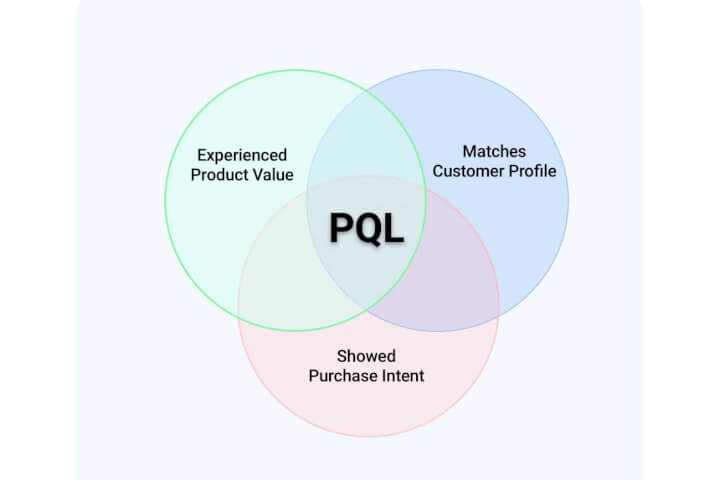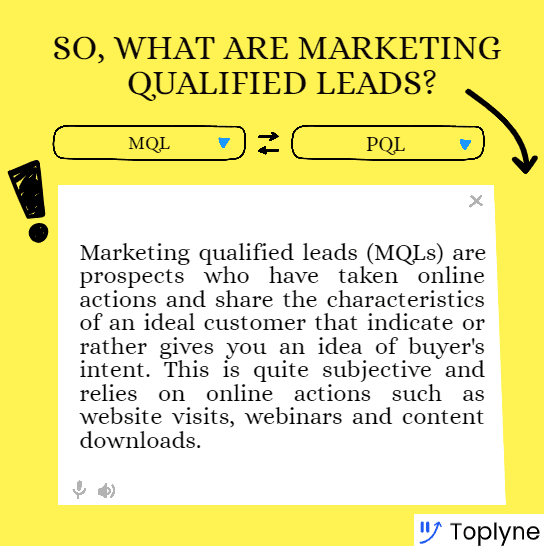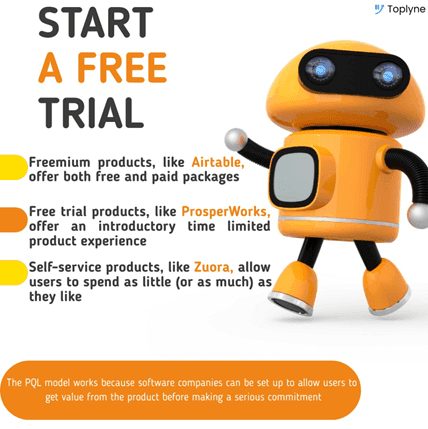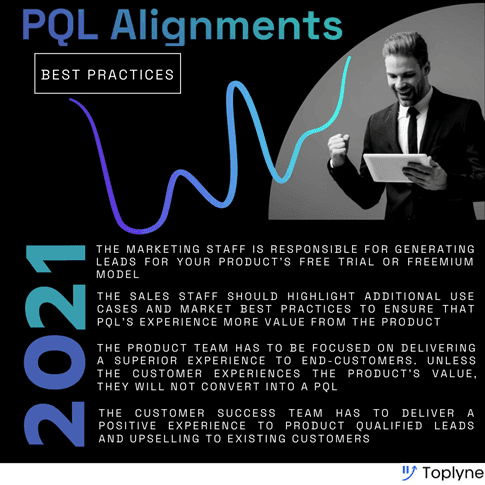What are PQL's? - the Future of SaaS Growth
What are PQL's? - the Future of SaaS Growth
What are PQL's? - the Future of SaaS Growth
The complete guide to product-qualified leads for PLG professionals
The complete guide to product-qualified leads for PLG professionals
The complete guide to product-qualified leads for PLG professionals



“Are you losing quality leads daily and paying too much for those who aren't a better match for what you offer?”
Terms such as a Sales Qualified Lead (SQL), Product Qualified Lead (PQL), and Marketing Qualified Leads (MQLs) are buzzwords you're likely to hear in the growth industry. While it might appear that the definition of the above words can be inferred directly, this is often not the case. To completely understand what Product Qualified Leads are, we must first comprehend what leads are.
A lead is an individual or institution that has shown interest in what you're offering. As a result, you'll require a method to evaluate leads based on their interaction with your product. While each company's interpretation of acquiring leads may differ, determining a unique line of communication in your marketing and sales adds clarity to bring in more revenue.
Now that you know the basics, let me ask you a question:
Can a PQL model assist your marketing team to crack down the most significant sales opportunities amongst your free trial users?
Confused? No problem. Let’s dive into some fundamental concepts.
Lead Qualification is Not New
Traditionally, trying to sell software in earlier days required a high-touch, revenue approach. Software companies relied on demos to generate prospects by physically revealing a product to a client. This sales procedure continued for a long time until software companies developed the theory of PQLs and MQLs. This strategized theory reduced the risk of a client purchasing the product by replacing it with free trials, where customers were given the opportunity to try the product for free and determine whether its features matched what they needed. This method of experiencing a product encourages customers to educate themselves about the service and experience its significance first-hand without making any investment!

Understanding Your Customers–oh my!
You will struggle to craft the ideal message for your users if you do not take the time to understand who they are, what they are doing on your site, why they wanted to sign up in the first place, and what goals they are attempting to achieve. To better understand your biggest clients, you must collect and learn from various customer data sets. When one of your objectives is to boost trial to funded conversions, this is a critical phase of the process, and this level of comprehension is the basis of everything.
What are Product Qualified Leads?
So, we can all agree that a product-qualified lead is a consumer who has seen the worth of your software package, usually through a free version or freemium login. PQLs are people who will use your product because they believe it is useful. And when this valued product is being explored, it is more likely to turn into a lead, increasing product-led growth. It is easier to advertise at this juncture as they already understand the organization's information, economic advantages, and worth.
When your product sells itself, that lead is more likely to convert into a customer. They do not become PQLs simply by signing up for a free trial. To become frequent paying customers, they must browse through the product's different features, ask related queries, and enquire further. Such individuals are more likely to become potential buyers and provide sales opportunities for your representatives.

WHY PQLs?
PQLs serve as the foundation for satisfied customers. The company invests less time and expense to bring these customers on board. There is recurring revenue as well as increased opportunities for increasing sales, cross-selling, and engagement. To succeed with a product-led growth strategy, you must concentrate on increasing PQLs using two strategies:
Using the product to improve sales
Ensuring customer success
Making a product-led strategy your core will guarantee customer engagement and conversion, which will ensure success. Therefore to develop a successful PQL process, you must describe what qualifies as a Product Qualified Lead and develop a program for engaging with those leads.
So, you’re convinced. Fantastic! Now all you need is an alignment to implement the same in your organization.
How Should PQLs Be Implemented in Your Organization?
If your company has defined its PQL, the next step is to put procedures and systems in place to develop product-qualified leads. It is important to ensure alignment on key metrics tracked by teams such as marketing, sales, and customer success.

Bottom Line
Having a bunch of the hottest sales opportunities is useless unless you act on them.
But how do you do it, and how do you make the most of your PQL data?
The goal is to determine WHO to contact when a trial version or freemium user has demonstrated a purchasing intent. This customer information allows you to offer a marketing opportunity that makes a difference.
PQL data also tells you WHEN you should pursue those opportunities. When you analyze PQLs, you can tell when someone is ready to talk to you. As a result, you never waste time reaching out to leads who aren't interested in speaking with you.
Finally, PQL data can assist you in making your outreach more relevant and engaging. Essentially, it demonstrates HOW to begin the sales conversation through CRM, that can help make your outreach more relevant to the individual.
All of this information is very good for now, but how would you convert this data into earnings?
You understand what Product Qualified Leads are—fantastic! You even know which PQL alignments to follow—superb! You must now take action. Track usage information of the customer during the trial period and send Product Qualified Leads to your sales department. Ring the gong.
“Are you losing quality leads daily and paying too much for those who aren't a better match for what you offer?”
Terms such as a Sales Qualified Lead (SQL), Product Qualified Lead (PQL), and Marketing Qualified Leads (MQLs) are buzzwords you're likely to hear in the growth industry. While it might appear that the definition of the above words can be inferred directly, this is often not the case. To completely understand what Product Qualified Leads are, we must first comprehend what leads are.
A lead is an individual or institution that has shown interest in what you're offering. As a result, you'll require a method to evaluate leads based on their interaction with your product. While each company's interpretation of acquiring leads may differ, determining a unique line of communication in your marketing and sales adds clarity to bring in more revenue.
Now that you know the basics, let me ask you a question:
Can a PQL model assist your marketing team to crack down the most significant sales opportunities amongst your free trial users?
Confused? No problem. Let’s dive into some fundamental concepts.
Lead Qualification is Not New
Traditionally, trying to sell software in earlier days required a high-touch, revenue approach. Software companies relied on demos to generate prospects by physically revealing a product to a client. This sales procedure continued for a long time until software companies developed the theory of PQLs and MQLs. This strategized theory reduced the risk of a client purchasing the product by replacing it with free trials, where customers were given the opportunity to try the product for free and determine whether its features matched what they needed. This method of experiencing a product encourages customers to educate themselves about the service and experience its significance first-hand without making any investment!

Understanding Your Customers–oh my!
You will struggle to craft the ideal message for your users if you do not take the time to understand who they are, what they are doing on your site, why they wanted to sign up in the first place, and what goals they are attempting to achieve. To better understand your biggest clients, you must collect and learn from various customer data sets. When one of your objectives is to boost trial to funded conversions, this is a critical phase of the process, and this level of comprehension is the basis of everything.
What are Product Qualified Leads?
So, we can all agree that a product-qualified lead is a consumer who has seen the worth of your software package, usually through a free version or freemium login. PQLs are people who will use your product because they believe it is useful. And when this valued product is being explored, it is more likely to turn into a lead, increasing product-led growth. It is easier to advertise at this juncture as they already understand the organization's information, economic advantages, and worth.
When your product sells itself, that lead is more likely to convert into a customer. They do not become PQLs simply by signing up for a free trial. To become frequent paying customers, they must browse through the product's different features, ask related queries, and enquire further. Such individuals are more likely to become potential buyers and provide sales opportunities for your representatives.

WHY PQLs?
PQLs serve as the foundation for satisfied customers. The company invests less time and expense to bring these customers on board. There is recurring revenue as well as increased opportunities for increasing sales, cross-selling, and engagement. To succeed with a product-led growth strategy, you must concentrate on increasing PQLs using two strategies:
Using the product to improve sales
Ensuring customer success
Making a product-led strategy your core will guarantee customer engagement and conversion, which will ensure success. Therefore to develop a successful PQL process, you must describe what qualifies as a Product Qualified Lead and develop a program for engaging with those leads.
So, you’re convinced. Fantastic! Now all you need is an alignment to implement the same in your organization.
How Should PQLs Be Implemented in Your Organization?
If your company has defined its PQL, the next step is to put procedures and systems in place to develop product-qualified leads. It is important to ensure alignment on key metrics tracked by teams such as marketing, sales, and customer success.

Bottom Line
Having a bunch of the hottest sales opportunities is useless unless you act on them.
But how do you do it, and how do you make the most of your PQL data?
The goal is to determine WHO to contact when a trial version or freemium user has demonstrated a purchasing intent. This customer information allows you to offer a marketing opportunity that makes a difference.
PQL data also tells you WHEN you should pursue those opportunities. When you analyze PQLs, you can tell when someone is ready to talk to you. As a result, you never waste time reaching out to leads who aren't interested in speaking with you.
Finally, PQL data can assist you in making your outreach more relevant and engaging. Essentially, it demonstrates HOW to begin the sales conversation through CRM, that can help make your outreach more relevant to the individual.
All of this information is very good for now, but how would you convert this data into earnings?
You understand what Product Qualified Leads are—fantastic! You even know which PQL alignments to follow—superb! You must now take action. Track usage information of the customer during the trial period and send Product Qualified Leads to your sales department. Ring the gong.
Related Articles




Behavioral Retargeting: A Game-Changer in the Cookieless Era
Unlock the power of behavioral retargeting for the cookieless future! Learn how it personalizes ads & boosts conversions. #behavioralretargeting




All of Toplyne's 40+ Badges in the G2 Spring Reports
Our customers awarded us 40+ badges in G2's Summer Report 2024.




Unlocking the Full Potential of Google PMax Campaigns: Mastering Audience Selection to Double Your ROAS
Copyright © Toplyne Labs PTE Ltd. 2024
Copyright © Toplyne Labs PTE Ltd. 2024
Copyright © Toplyne Labs PTE Ltd. 2024
Copyright © Toplyne Labs PTE Ltd. 2024